Putting together an “Eyesores” issue isn’t as easy as you might think.
After all, where do you even start — or, more accurately, stop? Vast areas of North and South Memphis are almost painful to look at: blocks and blocks of abandoned buildings and decaying industrial sites. And it’s not just confined to regions outside the expressway loop. Urban blight pops up like acne throughout Midtown, East Memphis, Hickory Hill, and beyond.
But to qualify for an eyesore, we decided to focus on specific sites or buildings that stood out from their surroundings — properties that, if improved or even removed — would surely make a difference to their neighbors.
Some things, it seems, never change. We looked at eyesores several years ago in the Flyer, and it was disturbing how many of those properties could have made the current list. The Sterick Building, for one, should earn a Lifetime Under-Achievement Award, since the downtown landmark once proclaimed “The Showplace of the South” has steadily decayed for the past 30 years or so, and in the current economic climate, we don’t expect that situation to improve anytime soon.
But sometimes we find glimmers of light among the ruins. The old Lowenstein/Rhodes-Jennings Building — a Main Street structure so decrepit that barriers were erected around it to shield pedestrians from falling debris — reopened several months ago as newly renovated condos.
So there is always hope, and we present the Eyesores of 2009 with that thought in mind: Boy, these places are ugly, but somebody, somewhere, may be able to make them useful, profitable, and even beautiful again.
1)Celebration Station
I-40 and Sycamore View
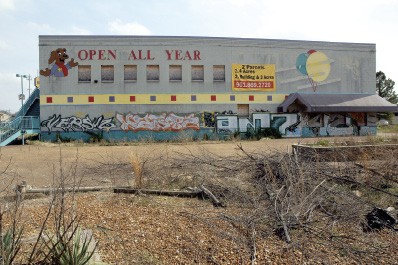 by Michael Finger
by Michael Finger
Celebration Station
Memphians may know how to have a good time, but we sure don’t like paying for it. Entertainment complexes don’t survive in this city. Old-timers can remember long-gone places like Rainbow Lake and Al’s Golfdom, and more recent losses include Skateland, Maywood, Adventure River, Malibu Grand Prix Raceway, and Jillians. (And let’s not forget Libertyland; see below.)
When Celebration Station opened in 1993, it was sensory overload for the thousands of visitors who packed the seven-acre complex day and night. Outside, the place offered two miniature golf courses with brightly painted castles and other elaborate obstacles, a spacious pool filled with bumper-boats equipped with outboard motors (when you grew weary of smacking into other boats, you just turned the motor 90 degrees and put yourself into a vertigo-inducing spin), and a figure-eight concrete race track, complete with an arched bridge and powerful Honda-engined go-karts.
Indoors held a food court, rows of old-timey Skeeball lanes, all sorts of coin-operated arcade games and rides, and private rooms for birthday parties and other events. But then it all came grinding to a stop. In 2001, the owners closed the park for the season, and if they ever reopened, no one noticed. People driving along the expressway surely wondered why it was dark and quiet, and every day, it seemed, the grounds attracted more trash and graffiti. Today, Celebration Station is a depressing shell of its former self. The go-kart tracks remain, but the bumper-car pool is filled with scummy water, and there’s not a trace of the miniature golf courses. A faded sign still beckons, in a mocking way, “Open 24 Hours.”
2)Clayborn Temple
280 Hernando
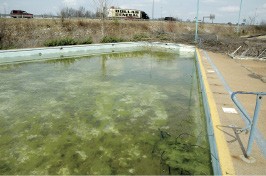 by Michael Finger
by Michael Finger
Celebration Station
For better or worse, three landmarks from the American civil rights movement are located in Memphis: the National Civil Rights Museum, Mason Temple, and Clayborn Temple. The first two look a whole lot better than the last one.
The authors of Memphis: An Architectural Guide, perpetuate an urban myth by saying, “In this building, Martin Luther King Jr. gave his ‘I have been to the mountaintop’ speech before he was assassinated.” No, they’re wrong about that; King gave that speech at Mason Temple (just south of Crump Blvd.) on the evening of April 3, 1968. But they are correct when they say this building — constructed in 1892 as Second Presbyterian Church — “is one of the most imposing churches in the city.”
In the 1960s, Clayborn Temple served as a rallying ground for many civil rights demonstrations, and it was often the starting point for protest marches to City Hall. As late as the 1980s, it was still used as a sanctuary, but the years have taken their toll. Membership declined, and it didn’t help when the church pastor resigned amid allegations of rape and battery. “Clayborn has just had problems all around,” said a leader of the AME Church in Atlanta, which owns the property.
In the late 1990s, construction of FedExForum directly across Linden supposedly weakened the rear wall of the old church, and an unstable wing had to be demolished. At one point the Memphis City Council appropriated $150,000 to help restore the building, but the money was rescinded after complicated legal arguments about the separation of church and state. And so for years, it has stood as you see it here, its sturdy grey stonework set off by peeling white plywood.
3)Ambassador Hotel
345 S. Main
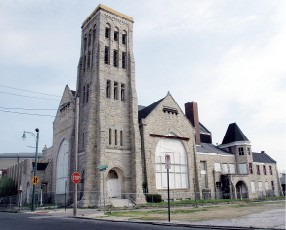 by Michael Finger
by Michael Finger
Clayborn Temple
Early in the 1900s, South Main was a beehive of activity, lined with family-owned businesses, shops, and small industries. Union Station and Central Station brought hundreds of visitors and tradesmen into the district, and many of them needed affordable places to stay, so small hotels and rooming houses opened up on just about every block.
The Ambassador was one of the largest of these medium-budget hotels, a sprawling place that originally occupied three separate buildings. One of those structures burned to the ground years ago, and another fronting on Vance has been converted into nice condominiums. The main hotel structure on South Main closed in the mid-1970s and has remained vacant ever since. In 1997, Memphis Heritage put the Ambassador Hotel on its list of the top 11 most endangered sites in Memphis, but that didn’t inspire any action except to board up the windows.
Over the years, a series of developers have announced they would transform the old building into a thing of beauty, usually in the form of shops or condos, but so far that hasn’t happened. Just about every building on this stretch of South Main has been revamped except this one. The exterior still looks decent, but vandals and vagrants who have crept inside have made a shambles of the interior.
4)Trousseau
1775 Union
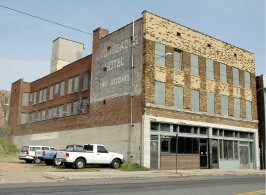 by Michael Finger
by Michael Finger
Ambassador Hotel
It stands like a gray ghost along Union Avenue, a relic from a bygone age that really wasn’t so long ago. As recently as the 1960s, women who wanted the finest fashions in town didn’t flock to the suburban malls — for the simple reason those malls didn’t exist. Instead, they shopped at high-quality stores downtown and in Midtown, and Trousseau was one in an exclusive group that included Helen of Memphis, Minor Francis, Julius Lewis, and others. But when the malls opened, the boutique shops were doomed. Most of them were demolished; the once-proud Helen of Memphis is now a parking lot for Rite Aid.
Trousseau, which opened in 1949 and moved to the present location in 1974, closed in 2001 when the owners opened a new location in East Memphis (which closed a few years later). The empty building on Union is practically surrounded by parking for its next-door neighbor, Schnucks, which badly needs more space, so it’s just a matter of time before the old lady comes tumbling down.
5)Quality Inn
271 W. Alston
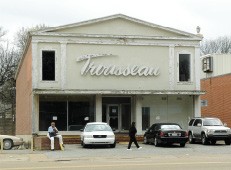 by Michael Finger
by Michael Finger
Trousseau
Developers constantly tout “location, location, location,” and in the 1960s, a motel facing the main highway leading into Memphis from Arkansas probably seemed like a great idea. Opened in 1967, the 150-room Quality Inn did a booming business — for a while. But just a few years later, the new Hernando DeSoto Bridge stretched across the Mississippi River, and most of those travelers switched to I-40. Tourist business along Crump Blvd. slowed to a crawl, the Quality Inn declined, and the building finally closed in the 1970s.
The good news is that the property is in the hands of developer Lauren Crews, who is presently transforming a derelict landmark nearby, the old U.S. Marine Hospital, into upscale residences. “That motel building stands at the gateway, so to speak, for our other developments,” says Crews, “so we certainly want to do something with it.” For a while, the fate of the property seemed in limbo, since the Tennessee Department of Transportation is looking at ways to improve the Crump Blvd./Riverside Drive/Memphis-Arkansas Bridge interchange (a confusing mess for anyone who’s tried to find the National Ornamental Metal Museum), but Crews says that the two options now on the TDOT table will spare the old motel.
“It may look awful from the outside, but it’s a solid concrete building and actually in good shape,” Crews says. “It’s got a great layout and could be easily converted into condos, apartments, or even back into a motel, for that matter.”
6)Medical Center Tower
Madison and Pauline
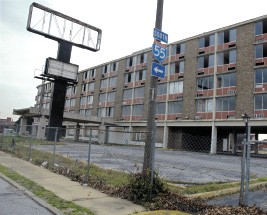 by Michael Finger
by Michael Finger
Quality Inn
This is an oddity — one of the city’s eyesores that many people don’t really notice — until they look up and see the empty 19-story building looming overhead, looking quite forlorn. The Medical Center Tower opened in the 1960s as a Holiday Inn, complete with a seven-story parking garage on the lower floors, a nice restaurant, and a swimming pool on the roof. The motel closed in 1989 and sat dormant for several years. In 1995 developers announced they would renovate the structure and reopen it as a smaller Holiday Inn, with some of the lower floors devoted to office space. Well, that never happened, and a year later The Commercial Appeal reported that the building’s status was “murky.”
Over the years, other developers pondered using the building as apartments and offices, but they never did anything about it. Finally, in 2005, the Memphis Bioworks Foundation purchased the property for $500,000 and announced they would tear it down to make more space available for UT Baptist Research Park. No date has been set for its demolition, but we hope they bring it down with a blast of dynamite as they did with the old Baptist Hospital. That was so cool.
7)Libertyland
E. Parkway and Central
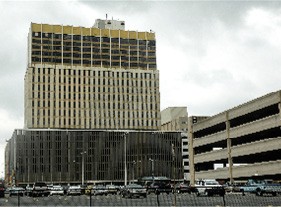 by Michael Finger
by Michael Finger
Medical Center Tower
Libertyland opened in 1976 as “America’s Bicentennial Theme Park.” In addition to rides and midway games, there was a miniature Statue of Liberty and a truncated Independence Hall. Visitors could explore Mark Twain’s Island, get splashed in the log-flume ride, ice-skate in an open-air pavilion, and — you’d generally save this for last — ride the famous Zippin Pippin, supposedly the oldest wooden roller coaster in America.
Across the country, though, children and their families seemed to lose interest in these little homespun amusement parks, lured away by Disney World, “fun line” cruise ships, and other vacation destinations. One by one, the smaller places closed, and Libertyland soon joined the list, as developers announced plans for a better location for the Mid-South Fair and a more profitable use (they hoped) for the property occupied by what one of our colleagues called “Little-Bitty Land.”
The closing of Libertyland was quite a mess. Owners of an amusement park in North Carolina somehow ended up with the entire Zippin Pippin when they wanted to purchase just a few of its cars (especially the one favored by Elvis Presley). Before they could dismantle the thing, however, the city stepped in and declared that sale invalid, but not before just about every other piece of the park that could be removed was auctioned off.
Today the old park should be called Lonelyland. Although Friends of Libertyland bemoan its fate, Henry Turley, developer of Harbor Town and Uptown, among other grand ventures, and a group of investors have unveiled plans for Fair Ground, an ambitious project that would also embrace the aging Liberty Bowl Memorial Stadium and the now-closed Mid-South Coliseum. The only thing they are waiting on is the same thing that is holding up many projects: money.
8)Frisco and Harahan Bridges
Mississippi River
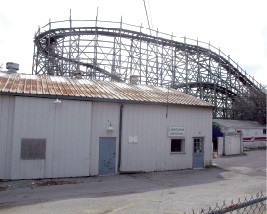 by Michael Finger
by Michael Finger
Libertyland
When it opened in 1892, the Frisco Bridge was an engineering marvel — the longest bridge in North America and the third-longest span in the world. It only carried one set of railroad tracks, though, so it was joined in 1916 by the Harahan Bridge, which not only carried more trains but also featured one of the scariest travel adventures in the country. A narrow, wooden roadway was suspended from each side of the bridge, just a low railing separating nervous drivers from the Mississippi River far below. An unexpected hazard was revealed in 1928, when sparks from a passing train set those planks afire. Though the roadways were eventually rebuilt, the automobile traffic dilemma wasn’t really resolved until the Memphis-Arkansas Bridge opened in 1949.
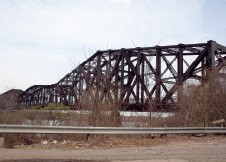 by Michael Finger
by Michael Finger
Harahan Bridge
All three bridges are still in use today, the Frisco and Harahan carrying freight trains on a daily basis. They were so sturdily constructed that they will probably stand for another century. But they sure look like hell, don’t they? The ownership of a railroad bridge can be a complicated mess — often a joint venture between the states and the various railroads who use it — but would it really be that much trouble to slap a coat of silver paint on these things every 10 years or so?
9)Chicago Pizza Factory
Madison, near Overton Square
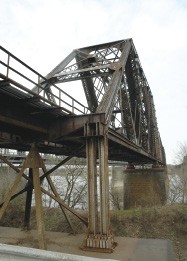 by Michael Finger
by Michael Finger
Frisco Bridge
When it opened in 1970, Overton Square was the city’s premier entertainment district, a grouping of some 30 shops, clubs, and restaurants. Centered around the intersection of Madison and Cooper, the district soon stretched down the street and eventually included this building, which opened in 1972 as Sweet Caroline’s and later changed its name to the Chicago Pizza Factory. Overton Square eventually lost much of its appeal, and this business locked its doors in 1989, but the building has remained something of a time capsule. Peer through the windows, and you’d think it closed last night. Tables and chairs, complete with salt and pepper shakers and napkin holders, are still inside, as if diners had just stepped away. The owner, contacted numerous times by potential buyers, steadfastly refuses to sell the property.
10)Chisca Hotel
272 S. Main
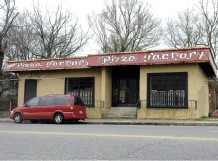 by Michael Finger
by Michael Finger
Chicago Pizza Factory
Old-timers don’t have any trouble listing downtown’s “grand” hotels: Peabody, Gayoso, King Cotton, and even Wm. Len. Then there were the “second-tier” properties, such as Chisca. An imposing structure with nice stained-glass details here and there, it mainly catered to businessmen working in the South Main area. The authors of Memphis: An Architectural Guide dismiss it, commenting that “it was clearly built on the cheap; there is little here that is not strictly utilitarian.” Maybe so, but anyone who held high school formals here in the 1960s and ’70s thought the old Chisca was something special. And it has a historic importance, too, for radio station WHBQ was located off the lobby. It was from here that deejay Dewey Phillips conducted the first on-air interview with a young singer named Elvis Presley.
Like most downtown hotels, the Chisca closed in the 1970s. The property and a newer addition called the Chisca Plaza Motor Court were purchased by the Church of God in Christ, which has made part of the building their headquarters. Unfortunately, the church has allowed the main structure to deteriorate, and upstairs windows have been open to the elements — and pigeons — for years.
11)Third Street Post Office
555 S. Third
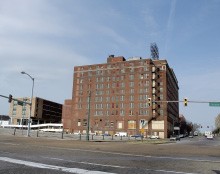 by Michael Finger
by Michael Finger
Chisca Hotel
Not all eyesores are old or abandoned buildings. The post office on Third Street makes our list mainly because we are still bitter about what it replaced — Union Station, complete with domes and arches and tiles and all sorts of wonderful ornamentation, a place the authors of Memphis: An Architectural Guide called “the finest Beaux Arts structure ever built in Memphis.” That came tumbling down in the late 1960s, when travelers took to the skies instead of the rails, and it was replaced by … this.
In the past, public buildings, especially big-city post offices, were grand edifices, with soaring entrances, marble concourses, and other adornments. But this is neither an impressive nor inviting structure. It’s a brutal-looking, top-heavy fortress, three floors of “bushhammered concrete.” Its main entrance is a dinky pair of aluminum doors that lead to a bare parking lot, and everything about the building says, “Go away.” It just makes our eyes hurt to look at it.
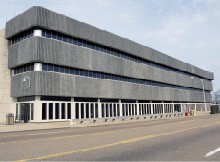 by Michael Finger
by Michael Finger
Third Street Post Office
 by Michael Finger
by Michael Finger  by Michael Finger
by Michael Finger  by Michael Finger
by Michael Finger  by Michael Finger
by Michael Finger  by Michael Finger
by Michael Finger  by Michael Finger
by Michael Finger  by Michael Finger
by Michael Finger  by Michael Finger
by Michael Finger  by Michael Finger
by Michael Finger  by Michael Finger
by Michael Finger  by Michael Finger
by Michael Finger  by Michael Finger
by Michael Finger  by Michael Finger
by Michael Finger